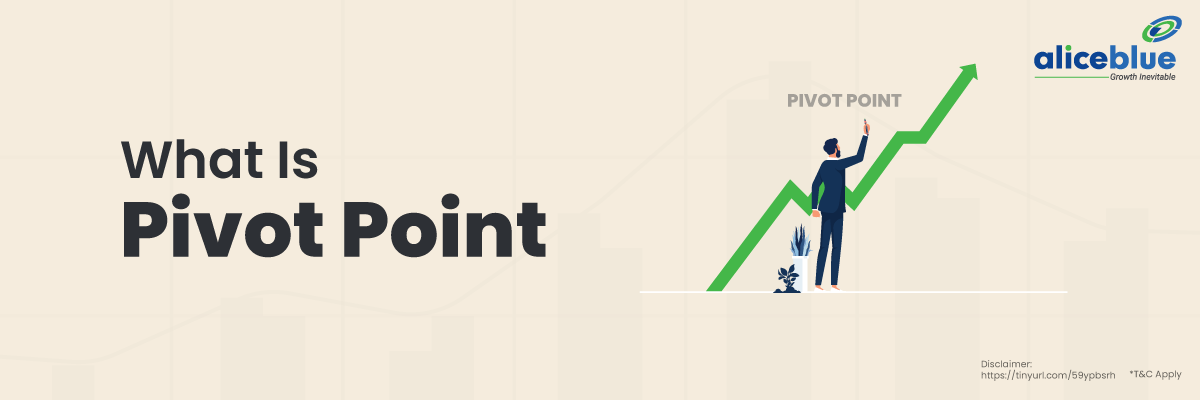A Pivot Point is a technical indicator commonly used in financial trading to measure the overall market trend across various time frames. It serves as a predictive tool that traders utilize to identify potential areas of support and resistance, helping them make informed decisions on entry and exit points in the market.
Contents :
- Pivot Point Meaning
- How To Calculate Pivot Points?
- Pivot Formula
- Pivot Point Trading Strategy
- What Is Pivot Point – Quick Summary
- Pivot Point Meaning- FAQs
Pivot Point Meaning
A Pivot Point serves as a predictive indicator and is used by traders to forecast potential points of price movement. It is calculated as an average of significant prices (high, low, close) from the performance of a market in the prior trading period.
For example, if the Nifty 50 closed at 16,000, reached a high of 16,100, and a low of 15,900 during the previous trading session, the Pivot Point would be calculated using these three values to forecast potential support and resistance levels for the next trading session.
How To Calculate Pivot Points?
Calculating Pivot Points involves taking the average of a financial asset’s high, low, and closing prices from the previous trading day. This average serves as the basis for creating support and resistance levels.
- Step 1: Identify the high, low, and closing prices from the previous trading day.
- Step 2: Add these three prices together.
- Step 3: Divide the sum by 3 to get the Pivot Point.
You can easily figure out your Pivot points with the help of Alice Blue.
Pivot Formula
Pivot Point Formula = (High + Close + Low) / 3
Pivot Point Trading Strategy
Pivot Points are not just theoretical constructs; they are actively used in trading strategies. These strategies often involve setting target prices and stop-loss levels based on calculated Pivot Points.
- Identify Market Trend: Use the Pivot Point as a basis for understanding the market trend.
- Set Entry Points: The first support and resistance levels can be used as potential entry points.
- Determine Stop-Loss: Place a stop-loss near a key Pivot Point level to minimize risk.
- Set Profit Targets: Use higher resistance levels as profit targets if you are going long, and lower support levels if you are going short.
We hope that you are clear about the topic. But there is more to learn and explore when it comes to the stock market, commodity and hence we bring you the important topics and areas that you should know:
| Types of non performing assets |
| What is annual return |
| Gross NPA vs Net NPA |
| What is Earnings per share |
| Fii Vs Dii |
| What is interim dividend |
| What is final dividend |
What Is Pivot Point – Quick Summary
- A Pivot Point is a technical indicator used to assess market trends and identify potential support and resistance levels.
- It is calculated using the high, low, and closing prices from the previous trading session.
- The formula for calculating the Pivot Point is straightforward and involves averaging these three prices.
- Trading strategies often incorporate Pivot Points to set entry and exit points, as well as stop-loss levels.
- Start your trading journey with Alice Blue, which offers a user-friendly platform at a low brokerage cost. Their advanced trading platform, ANT Mobi, allows traders to navigate the markets and place trades easily.
Pivot Point Meaning- FAQs
What Is Pivot Point?
The Pivot Point is a predictive technical indicator used in trading to identify potential price movement areas.
What Is The Formula For Pivot Point In CPR?
In the context of the Central Pivot Range (CPR), the formula for the Pivot Point remains the same as the standard Pivot Point = (High + Close + Low) / 3
Who Uses Pivot Points?
Pivot Points are commonly used by day traders, swing traders, and even long-term investors to gauge market sentiment and identify potential areas of price movement.
How Accurate Is Pivot Point Trading?
The accuracy of Pivot Point trading varies and is influenced by factors such as market volatility, trading volume, and overall market sentiment. However, it is generally considered a reliable tool when used with other indicators.
To understand the topic and get more information, please read the related stock market articles below.






